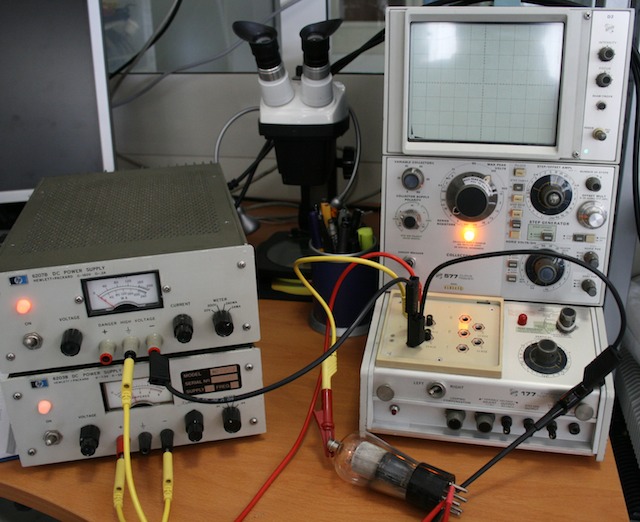UY224 plate characteristics measured with a curve tracer
UY224 plate characteristics measured with a curve tracer

This is a plot of the plate characteristics of the screen grid amplifier tube, measured with a Tektronix 577-177 curve tracer (577 is the display unit, 177 is the standard semiconductors test fixture).
As can be seen, negative-resistance section is clearly visible, when the plate voltage is between 10 and 90 volts, which was the screen-grid voltage.
Graph was annotated with the curve tracer controls settings, as follows:
- control grid step voltage: 2V per step
- Y-axis: 1 mA per division
- X-axis: 20V per division

Two external power supplies have been used to deliver power to the screen grid (90V) and the heater (2,5V).
It is very important to adjust the current limiter into the screen grid, as in some conditions during the sweep, and when plate voltage is disabled, it is easy to exceed the maximum permissible power dissipation.
The following image shows the test setup:

The following image shows as the plot is displayed on the screen of the curve tracer.

The negative-resistance portion of the plate characteristic was utilized to realize the dynatron oscillator (refer to RCA patent #2067366).
In the RCA cathode ray tube television receiver prototype of 1931, two dynatron oscillators equipped with UY-224 tubes provided the line (2880 Hz) and frame (24 Hz) signals to the magnetic deflection coils of the CRT.
A good description of this interesting television receiver can be found in the following websites:
RCA first CRT Television Receiver - 1931
Earlytelevision - RCA Television Receiver - 1932
Technical details of this television receiver are described in a paper by V.K.Zworykin - Description of an Experimental Television System and the Kinescope, Proceedings of the IRE, vol.21, no.12, pp.1655-1673, Dec. 1933 and reprinted in the Proceedings of the IEEE, vol.86, no.5, May 1998.
To thank the Author because you find the post helpful or well done.